The theme of this year’s annual benefit was Share in Something Greater. Sharon Prince, our CEO and Founder, discussed the many accomplishments over the eight years since our founding, demonstrating what we can accomplish together if we connect through our shared humanity. As Sharon pointed out, Teresita Fernandez’s extraordinary Double Glass River in the Commons provides all of us with an opportunity to see things differently and to recognize our interconnectedness.
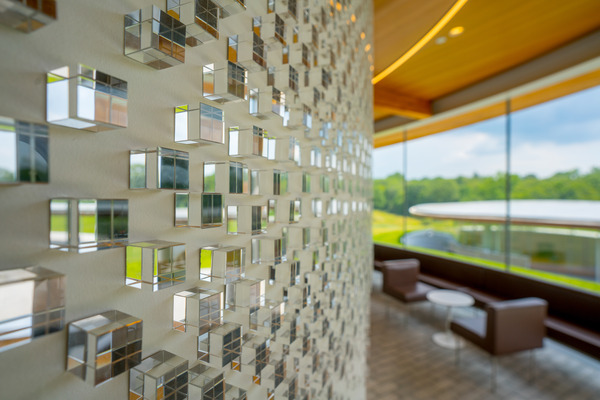
Below are highlights of what our team and leading partners from around the world accomplished together in 2023.
Experience Nature
Nature- and place-based programs
Nature-based programs and the place of Grace Farms has attraced thousands of people from around the world to experience the awe and wonder of nature. With over 30 nature-based programs offered each year, from education-based programs were families and children can explore the wonders of outer space to providing hands-on experience in learning about birds and their habitats on Grace Farms’ 80 acres of natural preserved landscapes.
This year, we added more experiential programming such as the Living Classroom with Horticulture Advisor Kimberly Kelly who demonstrated how native meadows can attract pollinators. In a conversation with Grace Farms’ Perspective on native meadows, we invited Kelly to discuss the importance of stewardship and native meadows. To compliment Kelly, Master Gardener and our Community Garden Manager, Lauren Elliott, invites visitors of all ages into the buzzing world of backyard beekeeping.

Our Garden to Table Dinner event, where more than 60% were first-time visitors to Grace Farms, Master Gardner Lauren Elliott and Pastry Chef Leah Jones, led a casual discussion about the produce and fruit from Grace Farms that was featured in the Garden to Table meal. Visitors were treated to a specialty dessert with fresh plum preserves (the plums were harvested from our orchard) that were presented in a sachet and attached to a Grace Farms recipe card from Pastry Chef Leah and a packet of jade seeds that Lauren had curated.
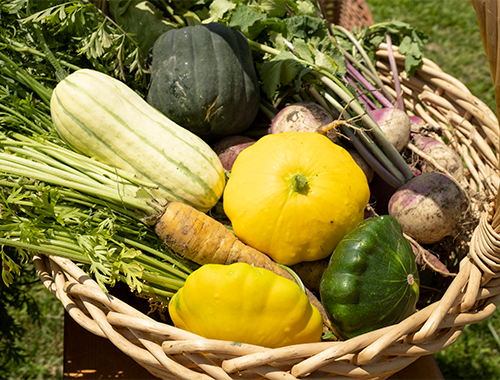
Our education team engages students with our award-winning building and natural landscapes, inviting students to reimagine the built environment and collaborate on new outcomes for a more ethical and sustainable world. This year, we welcomed 500 students from 12 different schools from Fairfield County to New Jersey. The education programs are designed to discuss architecture, nature, and align with the Next Generation Science Standards, Common Core, Connecticut Elementary and Secondary Social Studies Frameworks, and Social and Emotional Learning practices.
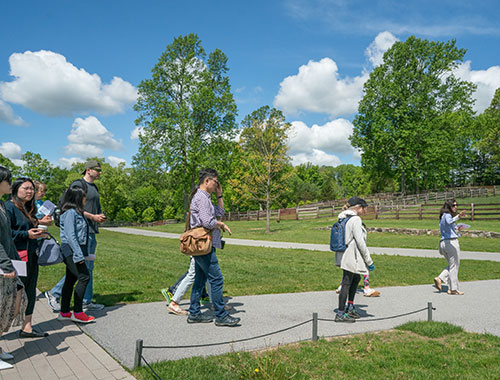
The 7 Acres Montessori school also visited with CEO of Grace Farms Foods, Adam Thatcher, to learn more about Grace Farms Foods and how it supports the work of Design for Freedom.
Encounter the Arts
The arts have been central to Grace Farms since its founding in October 2015, and since that time, more than 250 artists, including accomplished artists such as Carrie Mae Weems and Meredith Monk have shared their extraordinary talents with audiences here.
Voices of Culture Series
In January, we launched the Voices of Culture series curated by our Music Director, Marcus G. Miller, an accomplished saxophonist, and a graduate from Harvard University with a degree in mathematics. Miller who has performed at the Obama White House, The World Economic Forum at Davos, The Late Show with Stephen Colbert, and tours with Grammy-winner Jon Batiste, who is now featured in a Netflix documentary American Symphony. Miller was part of the historic performance of “American Symphony,” with Jon Batiste at Live with Carnegie Hall. Miller, whose inspired saxophone solo performance was a memorable moment of the evening, is bringing diverse voices to the community such as pianist Serene and Irwin Hall who performed in February with the Irwin Hall Organ Trio. Hall, an award-winning saxophonist, flutist, clarinetist, and composer, is known for his melodic improvisations.

Serene, a Bösendorfer Artist, (above) and classical pianist whose solo performances have been described by The Paris Review as “a spectacle to match the New York Philharmonic,” launched the series in January. Miller writes in his Voices of Culture Perspective, “In conversation, I found out that she was a classical pianist who played repertoire that I really enjoy. AND THEN, I found out that we shared the math/music brain as she was a computer programmer. Since then, I’d always wanted to find an opportunity to work with her.”
Other diverse voices that performed at Grace Farms this year include King Solomon Hicks, a guitarist, vocalist, songwriter, and composer from Harlem, who has been hailed as the most dynamic and acclaimed young artist in blues today, and Grammy-nominated artist and jazz vocalists Jazzmeia Horn.

“Horn is among the most exciting young vocalists in jazz …” – The New York Times
Horn also developed a Masterclass for Grace Farms where she invited artists and performers to learn more about the art of storytelling and finding one’s voice. “This is a life lesson, not just for the stage,” she said.

Bobby Sanabria‘s Multiverse Big Band also played to a sold-out audience in the Sanctuary in September. Sanabria, a seven-time Grammy nominated artist, celebrated drummer, composer, arranger, percussionist, and bandleader had people dancing in the aisles. “The band can turn on a dime from a concert jazz orchestra to a swinging dance band that can roar and whisper,” says The New York Times.

Just as Horn encourages emerging artists to discover their voices, Open Arts Studio for Families, continues to help thousands of children and their families each year to discover their artistic voices. Developed by our Arts Initiative Curator, Pamela Ruggio, the year-long program is a facilitated series designed by artists, curators, and educators that invites children and families to think, play, create, and spend time together experimenting with sensory-rich materials and different modes of art making.
Pursue Justice
“Today, hundreds of leaders of the built environment are standing together to issue a clarion call to action. We are not just in agreement that forced labor in the building materials supply chain is unethical and immoral. We are also in agreement that now is the time for action and true market transformation to design and build more humanely.” – Sharon Prince
First-Ever Design for Freedom Ethical Supply Chain Workshop
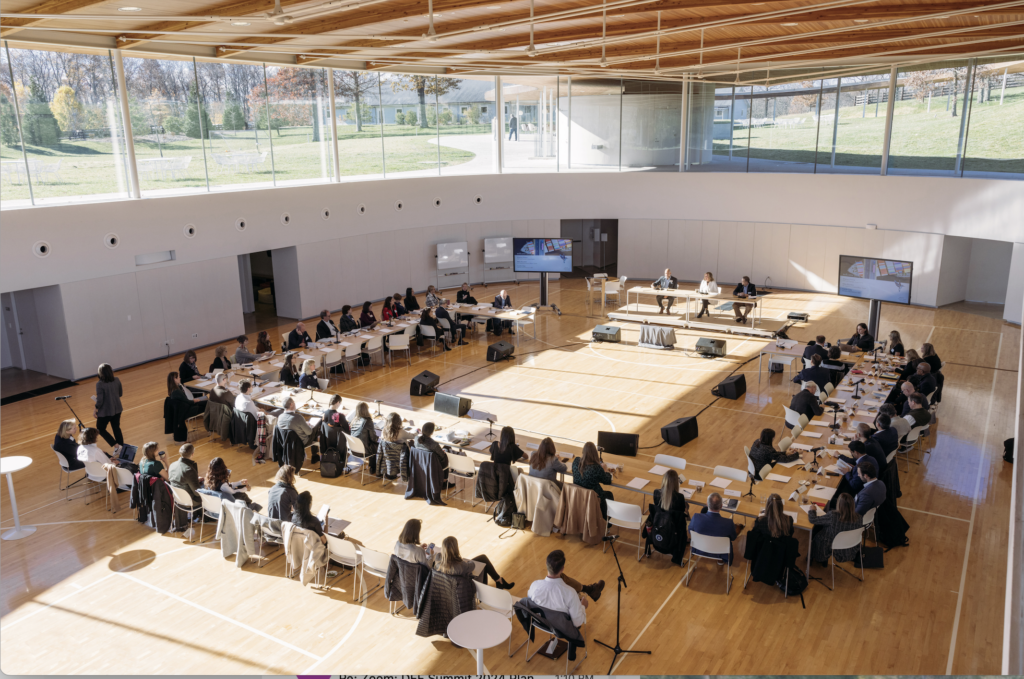
The Design for Freedom Ethical Supply Chain Workshop at Grace Farms.
On November 14, we welcomed over 80 leaders spanning the ecosystem of the built environment, including global manufacturers, developers, and contractors to Grace Farms for a full-day Design for Freedom Ethical Supply Chain Workshop, hosted in partnership with Turner Construction and the U.S. State Department Bureau of Overseas Buildings Operations (OBO). Together, we explored how we can take collective action to reduce the risk of forced labor in the building materials supply chain.

[l-r]: Curtis Clay, Director of Architecture at the U.S. Department of State Bureau of Overseas Buildings Operations, and Design for Freedom Working Group member, our CEO and Founder, Sharon Prince, and Mike Bruskin, Vice President and Chief Procurement Officer of Turner Construction Company, provide welcome remarks.
“True sustainability means that we care about how we do business. It is so much more than getting the work done. It means we care about the communities in which we work, the global environment, and all the people along our supply chain.” – Mike Bruskin, Vice President and Chief Procurement Officer of Turner Construction Company
Initializing ‘Ethical Decarbonization’
On September 12, at the Yale Club in New York City, United Nations Environment Programme (UNEP), Yale Center for Ecosystems + Architecture and the Global Alliance for Buildings and Construction (GlobalABC) released Building Materials and the Climate: Constructing a New Future. This first-of-its-kind report showcased how the construction industry could play a major role in addressing climate change. It was also the first time that the embedded suffering of forced labor in the building materials supply chain was linked to the climate crisis.
“This is a rare and promising time to initialize ‘ethical decarbonization’ to assess and lower both embodied carbon and embodied suffering in an opaque weighty marketplace that will have significant humanitarian impact.” – Sharon Prince, Yale Club
Design for Freedom Summit
On March 30, the Design for Freedom Summit brought together more than 500 leaders of the built environment, including more than 60 students from 23 universities, uniting with the shared goal to accelerate the global movement to eliminate forced labor from the building materials supply chain. As Prince said at the Summit, “We can no longer accept the slavery discount.” This would become a headline of Dezeen‘s coverage of the Summit.
The Summit featured panels on Accelerating the Movement with Pilot Projects; the Business Case for Design for Freedom moderated by Richard Lui of MSNBC, Supply Chain Transparency; roundtables discussion including Building Materials and the Climate Report by Yale CEA, UNEP and GlobalABC with featured author Anna Dyson, Founding Director of the Yale Center Ecosystems + Architecture, Converting Textile Transparency to Interiors, Global Policy as a Driver, Material Circularity + Tech Innovation, Timber Studies, and Tools for Material Transparency. Other participants included: Ana Hinojosa, Former Executive Director, U.S. Customs & Border Protection, and Advisor, Oritain; Curtis Clay, Director of Architecture U.S. Department of State’s Bureau of Overseas Buildings Operations; Pete Hamill, Senior Vice President, Strategic Development, and New England Principal Turner Construction; Maha Khan, Financial Sector Lead, Finance Against Slavery and Trafficking, United Nations University Center for Policy Research.
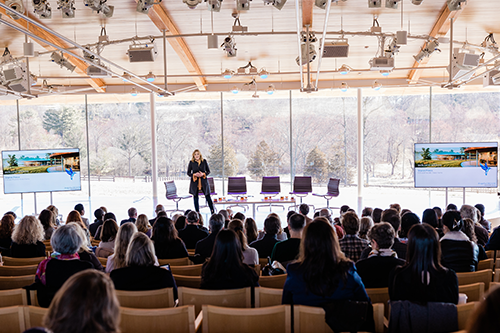
Grace Farms’ CEO and Founder Sharon Prince welcomes hundreds of attendees to the 2023 Design for Freedom Summit. Credit: Jacek Dolata
Pilot Projects Across Three Continents
At this year’s Summit, a new slate of Design for Freedom Pilot Projects was announced, all of which demonstrate that forced labor can be eliminated. There are now eight Pilot Projects to date that span across three continents. Below are the new Pilot Projects in the works:
The Grain Market, Jodhpur, India
Currently in design, this project is a collaboration with Design for Freedom and Diana Kellogg, founder of her award-winning firm. Kellogg is working with JDH Urban Regeneration Project, which is restoring the historic walled city of Jodhpur. Together, the historic grain market will be transformed it into a world-class farmer’s market with dining.
Unshattered’s Project Possibilities, Wappingers Falls, NY
This Pilot Project will provide new spaces to support Unshattered’s community, a not-for-profit social enterprise which helps women in recovery develop economic independence. One of the most unique and innovative organizations in this sector, Unshattered’s new welcoming space will foster community and provide expanded programming. The new space will be by MASS Design Group, a Design for Freedom Working Group member.
Page
A new building project designed by Page will incorporate the Design for Freedom process into one of its projects. Page, a global design, architecture, and engineering firm, is the recipient of the firm’s 2022 Blue Oceans Grant, an internal competition. The three projects being considered are a federal building, a mixed-use development project, and a hospital.
The Brij, New Delhi, India
This Pilot Project was announced by Chelsea Thatcher, Chief Strategy Officer, during the 2022 Summit, and is underway. This is a new center for arts and culture and will be designed for accessibility, inclusion, sustainability, and fairness. “In the arts and cultural center that Serendipity Arts is setting up in New Delhi, we are hoping to make this a model project, and we are delighted to partner with Grace Farms to turn this into a Design for Freedom Project,” said Sunil Kant Munjal, Founder Patron of Serendipity Arts.”
Serendipity Arts is working with CRAB Studio and ARUP on the project.
Two Pilot Projects Opened in 2023
Two previously announced pilot projects, the New Canaan Library and Shadow of a Face opened to the public this year.
The New Canaan Library, New Canaan, CT
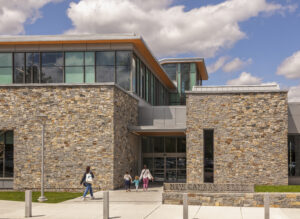
New Canaan Public Library, Location: New Canaan, Connecticut, Architect: Centerbrook Architects
On February 14, the New Canaan Library opened its new groundbreaking knowledge and learning center. Design for Freedom partnered with the library, Turner Construction, and Centerbrook Architects to explore and pursue the use of low-risk materials during the construction process. Together, we traced raw and composite building materials as far upstream as possible within the supply chain.
Shadow of a Face, Newark, NJ
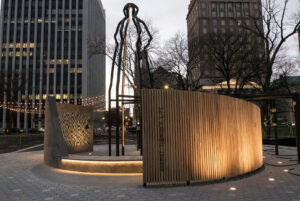
Photo credit: Cesar Melgar
On March 9, architect and artist Nina Cooke John unveiled Shadow of a Face to the public. The Harriet Tubman Monument is a two-story monument that encourages visitors to connect with Harriet Tubman, her story, and her extraordinary legacy. Design for Freedom worked with Cooke John on the transparent sourcing of materials for the monument, demonstrating her commitment to design and build with materials that are free of forced labor.
Cooke John is currently working on a Design for Freedom exhibition that will open at Grace Farms in 2024.
Foster Community
Making Space for Women
In March, Grace Farms presented several programs as a part of our Making Space for Women series, which honors the important role that women play in our communities, the contributions they have made, and the innovative work they are doing to advance good.

From left to right: Sharon Prince, Helene Gayle, Sian Leah Beilock, Frances Bronet, Laura Sparks, and Karen Kariuki, Senior Program Officer, Grace Farms Foundation. Photo by Melani Lust
One of the highlights of the series was Madam President | Women Leaders in Higher Education. Grace Farms convened visionary leaders in higher education who are moving education systems forward. The leaders included Sian Leah Beilock, then President of Barnard College and President-Elect of Dartmouth; Frances Bronet, President of Pratt Institute; Helene Gayle, MD, President of Spelman College; and Laura Sparks, President of The Cooper Union for the Advancement of Science and Art, and Sharon Prince, CEO and Founder of Grace Farms Foundation.
I think for all of us, some may have had very linear [careers], but I think one of the things that I always think about careers there’s always a through line … Because I think careers are really all about how you find your sense of purpose and your sense of meaning. – Helene Gayle
Highlights from their insightful discussion can be read in the Madam President: Women Leaders in Higher Education Perspective.
Explore Faith
Life Worth Living
Five years ago, our Faith Initiative Director Matthew Croasmun led the first-ever Life Worth Living course outside of Yale University, inviting a broader audience into the curriculum at Grace Farms.
In April, to celebrate the release of the New York Times‘ bestseller Life Worth Living: A Guide to What Matters Most, Kelly Corrigan, New York Times bestselling author and host of Tell Me More on PBS and the Kelly Corrigan Wonders podcast, hosted a conversation with co-authors Miroslav Volf, Founding Director of the Yale Center for Faith & Culture and Grace Farms Board Member, Matthew Croasmun, our then Faith Initiative Director and Director of the Life Worth Living Program at the Yale Center for Faith & Culture, and Ryan McAnnally-Linz, Associate Director of the Yale Center for Faith & Culture.
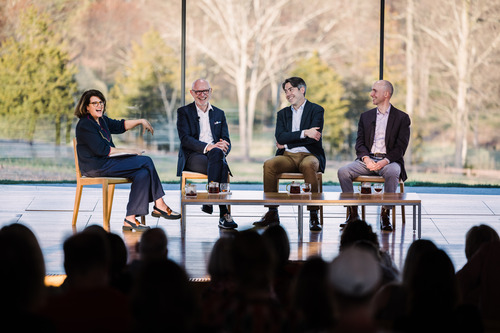
Left to right: Kelly Corrigan, Miroslav Volf, Matthew Croasman, and Ryan McAnnally-Linz speaking at Grace Farms’ Sanctuary.
In March, NBC’s Maria Shriver also interviewed Volf who shared his lessons in finding joy and what matters most in life. Here’s the full interview.
_____________________________________
New Place-based Programs
Conversations in Architecture & Behind the Scenes Tours
The River building has been awarded numerous awards over the years including the prestigious Mies Crown Hall Americas Prize (2014-2015). The jury “was struck by the radical way in which the line between architecture and landscape is blurred by the ‘River’ building … the Grace Farms project uniquely demonstrates architecture’s capacity to make a place for an innovative new institution,” as reported in the Architect. Prince attended the awards at the MCHAP Symposium and Award Dinner where the best built works of architecture in the Americas were honored. It was there that Prince realized architect can be a lever change and can advance good. The Design for Freedom movement would soon emerge from that idea.
To deepen the conversation around architecture, Grace Farms launched a series of tours with our Architecture Advisor Toshihiro Oki, (formerly of SANAA/Kazuyo Sejima + Ryue Nishizawa). In November, for instance, Oki engaged award-winning architects in conversation about transforming a house into an inviting home.
The architects, who have contributed to New Canaan’s reputation as an architectural destination, included Toshiko Mori, Founding Principal, Toshiko Mori Architect, Robert. P Hubbard Professor in the Practice of Architecture at Harvard University Graduate School of Design, and the recipient of such honors as the 2019 ACSA Topaz Medallion for Excellence in Architectural Education Award; Thomas Phifer, Founder of Thomas Phifer and Partners, who is known for his work on the new Museum of Modern Art in Warsaw and the award-winning expansion of the Glenstone Museum in Maryland; and award-winning architect Frederick Noyes, Principal, Frederick Noyes Architects, who is a member of the College of Fellows of the American Institute of Architects and Trustee Emeritus at Boston Architectural College. Noyes grew up in New Canaan at the Noyes House II, designed by his father Eliot Noyes, a member of the Harvard Five.
________________________________
In the Press
This year was another break-out year for press. Here are some highlights.
Sharon Prince is an “outspoken proponent for ‘architectural justice’ …” – Green Building Advisor
In the International Living Future Institute’s recently released book, The Regenerative Materials Movement: Dispatches from Practitioners, Researchers, and Advocates, a diverse range of thought leaders share their real-world stories, research, revelations, and insights about their bolds visions for overcoming the drawbacks of the current materials economy.
Sharon Prince also shares her own bold and ambitious vision of designing a more humane future in her essay Embodied Suffering in Our Building Materials. Prince is featured alongside leaders in their fields from organizations such as Google, JPB Foundation, MASS Design, Harvard University, Buro Happold, and mindful Materials.
As Green Building Advisor says in its review of the book, “Prince is an outspoken proponent for ‘architectural justice,’ and believes that materials cannot be considered truly regenerative or part of a circular economy until the global building industry no longer accepts the ‘slavery discount’ on such ubiquitous raw and composite materials like steel, glass, bricks, stone, copper, textiles, and timber. In her chapter she writes, ‘The largest industrialized sector with the highest risk of modern slavery is getting a labor transparency pass. It is stunning that today there is no ethical labor inspection of the building materials supply chain, which accounts for roughly 50 percent of the building’s cost.’”
Grace Farms Foods Featured in Forbes
Bringing people together over shared meals and a cup of tea or coffee has been central to Grace Farms since its beginning. In 2021, Grace Farms Foods, a public benefit LLC, and a Certified B Corp, 100% owned by Grace Farms Foundation, was launched. Grace Farms Foods demonstrates that the sourcing of tea and coffee free of forced labor is possible. 100% of profits from Grace Farms Foods supports the global Design for Freedom movement. Grace Farms Food is the first U.S.-based premium tea brand to partner with Fairtrade International and the only one that gives back 100% of profits to ending forced labor worldwide.
In the January Forbes article, “Steeped In Purpose: How A Coffee And Tea Company Is Forging A New Kind Of Social Entrepreneurship,” Forbes interviews Adam Thatcher, CEO of Grace Farms Foods, who shares his insights on this “innovative social enterprise structure.”

Frank Kwei, Grace Farms’ Tea Expert and Educator, serves tea in our Pavilion, a welcoming space where visitors can reflect over a cup of Grace Farms Foods’ tea. Like all the volumes in the River building, the Pavilion overlooks expansive landscapes.
“Coffee and tea are two global commodities that are often taken for granted as a delicious utility as we rush out the door. However, we want everyone to know that behind every coffee bean and every tea leaf, there are farmers, tea pickers, mothers, and oftentimes children that are harvesting and processing what will become your morning caffeine fix.”
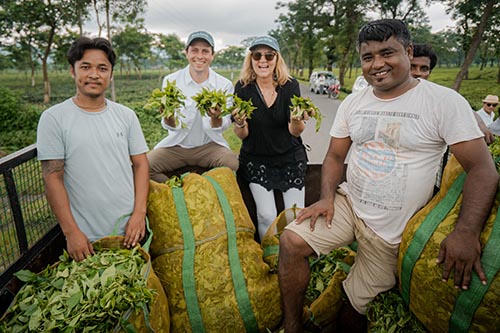
Adam Thatcher, second from left and Sharon Prince, visiting Fairtrade and organic tea suppliers in India in 2022. Photo credit: Siddhartha Joshi
Looking Forward to 2024
Opening of Design for Freedom Exhibit
This first-of-its-kind exhibit showcases the work of Design for Freedom led by Sharon Prince. The exhibit designed by Nina Cooke John and curated by Chelsea Thatcher, Grace Farms’ Founding Creative Director, will feature ethically sourced materials and shine a light on the issue of forced labor in the building materials supply chain. Graphics are by Pentagram: Eddie Opara, Pedro Mendes, Issabella Hindley-Cupper and the Biomaterials Installation by Yale Center for Ecosystems + Architecture.
“Understanding that humanity touches every single step along the way allows us to reimagine how architecture fits into the rest of our lives.” – Nina Cooke John, architect, artist, and founder of Studio Cooke John
To find out more about the Design for Freedom movement and how to get involved please contact us.
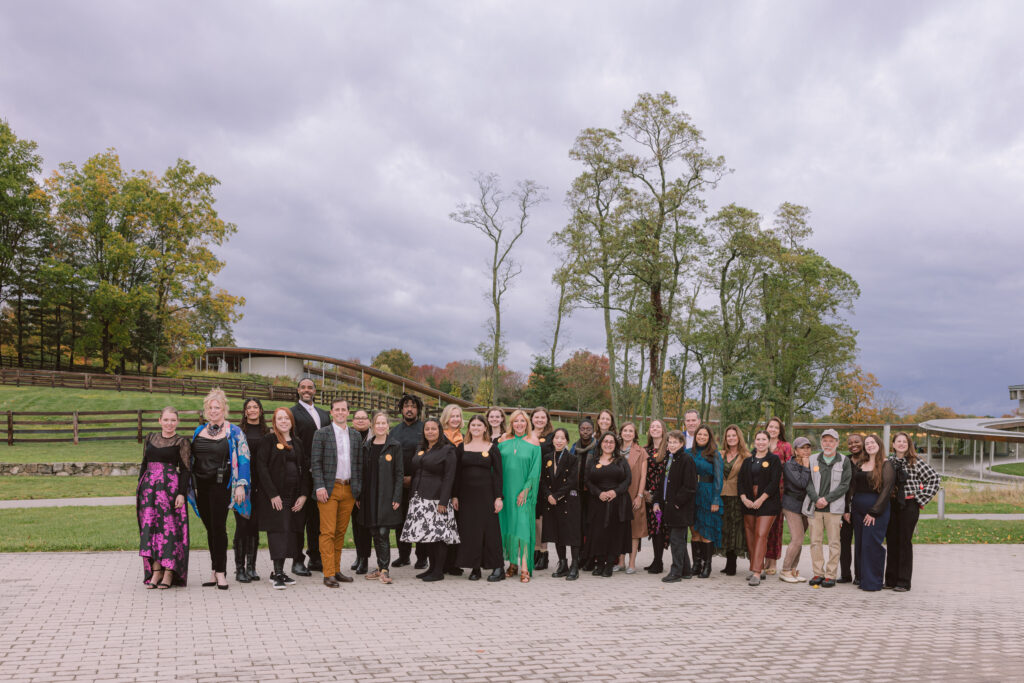
Our exceptional cross-disciplinary teams bring their unique skills and excellence to advancing good at Grace Farms.
About Grace Farms
Grace Farms is a center for culture and collaboration in New Canaan, Connecticut. We bring together people across sectors to explore nature, arts, justice, community, and faith at the SANAA-designed River building on 80 acres of publicly accessible, preserved natural landscape. Our humanitarian work to end modern slavery and foster more grace and peace in our local and global community includes leading the Design for Freedom movement to eliminate forced labor in the building materials supply chain.
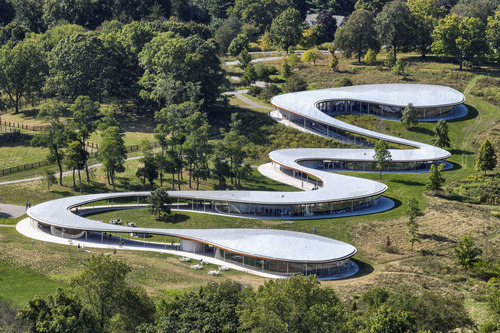
The SANAA-designed River building is embedded in 80 acres of natural landscape. Grace Farms is free and open to the public six days a week, other than Monday. Photo by Kyle Norton
Become a member
Grace Farms members enjoy special access to member-only events, experiential activities, and thought-provoking programs — and the opportunity to be a part of our mission to pursue a more peaceful world.
Learn more at gracefarms.org/membership
Visit our calendar of events to learn more about upcoming programs.
Sign-up for our newsletter
Follow us
@gracefarmsct #gracefarms

